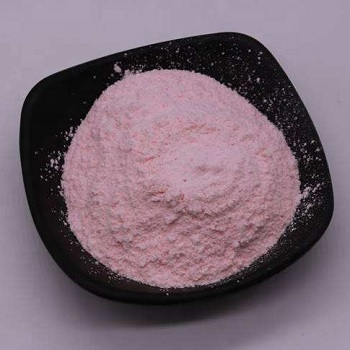1.1 Physcial Properties
The crystalline solid form of cobalt acetate is usually pink or red in color. At room temperature and pressure, it is often found in solid form. The anhydrous form of cobalt acetate has a melting point of around 140–150°C (284–302°F)[], however this might vary depending on the hydration state. Its solubility rises with temperature and it is soluble in both water and polar solvents, this solubility is a key feature that facilitates its use in various solutions and mixtures for industrial applications. 1.71 g/cm^3 is the approximate density of anhydrous cobalt acetate. Because unpaired electrons exist in the cobalt ion’s d orbitals, some cobalt acetate complexes behave paramagnetically[]. Cobalt acetate, particularly in its hydrated forms, has a propensity to take in moisture from the surrounding air. It has a vinegar-like odor, which is typical for acetate salts[5].

Figure 3: Cobalt acetate in its crystalline solid form
1.2 Chemical Properties
In an aqueous solution, cobalt acetate dissociates to produce cobalt ions (Co^2+) and acetate ions (CH3COO^-). In acidic environments, it is quite stable[]. The synthesis of different cobalt complexes, which usually involve the coordination of cobalt ions with acetate ligands and other auxiliary ligands, begins with cobalt acetate. Under the right circumstances, cobalt(II) may be oxidized to cobalt(III) in cobalt acetate and related complexes. Because cobalt acetate and its derivatives may coordinate with reactant molecules and engage in redox processes, they are utilized as catalysts in organic transformations, This catalytic activity is leveraged in the production of polymers, specialty chemicals, and in the pharmaceutical industry for the synthesis of various drugs. The ability of cobalt acetate to promote desired reactions and increase reaction rates makes it a valuable component in these processes[7]. When cobalt acetate is heated, it may become anhydrous by dehydrating and absorbing water from the environment to create hydrated complexes[]. A number of variables, including pH, temperature, and ligand type, affect how stable cobalt acetate complexes are[]. Cobalt acetate complexes have the capacity to interact with a wide range of ligands and substrates, affecting their stability, reactivity, and structure.
These chemical properties, combined with its physical characteristics, make cobalt acetate a versatile and valuable compound in various industrial and chemical applications
References
- Beattie, James K., et al. “The chemistry of cobalt acetate. VIII. New members of the family of oxo-centred trimers,[Co3 (μ3-O)(μ-O2CCH3) 5− p (μ-OR) pL5] 2+(R= H, alkyl, L= ligand, p= 0–4). The preparation and characterisation of the trimeric tetrakis (μ-acetato)-(μ-hydroxo)-μ3-oxo-pentakis (pyridine)-tri-cobalt (III) hexafluorophosphate, [Co3 (μ3-O)(μ-O2CCH3) 4 (μ-OH)(C5H5N) 5][PF6] 2, and the preparation and crystal structure of the trimeric tris (μ-acetato)-(μ-hydroxo)-(μ- methoxo)-μ3-oxo-pentakis (pyridine)-tri-cobalt (III ….” Polyhedron 22.7 (2003): 947- 965.
- Diemente, Damon. An electron paramagnetic resonance study of some cobalt complexes and their adducts with molecular oxygen. Northwestern University, 1971.
- Thabede, P. M. The effect of carboxylic acids on the size and shape of Co3O4 nanoparticles: used as capping molecules and ligands in the preparation method. Diss. Vaal University of Technology, 2017.
- Shen, Chaojun, et al. “Four new cobalt (ii) coordination complexes: thermochromic switchable behavior in the process of dehydration and rehydration.” CrystEngComm 14.9 (2012): 3189-3198.
- Yang, Luqin, et al. “Cobalt (II) and cobalt (III) dipicolinate complexes: solid state, solution, and in vivo insulin-like properties.” Inorganic Chemistry 41.19 (2002): 4859-4871.
